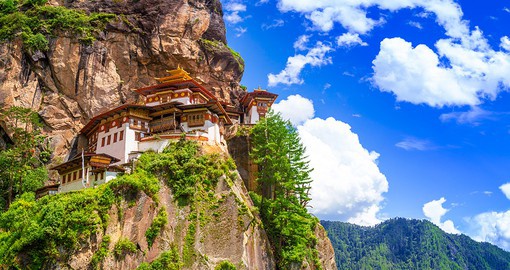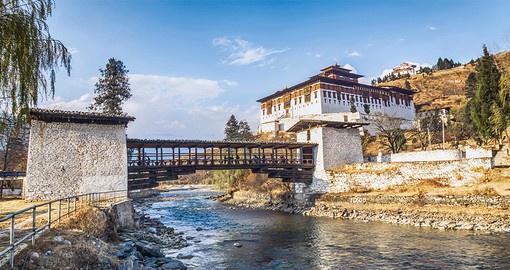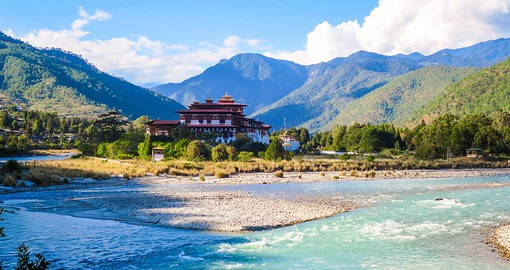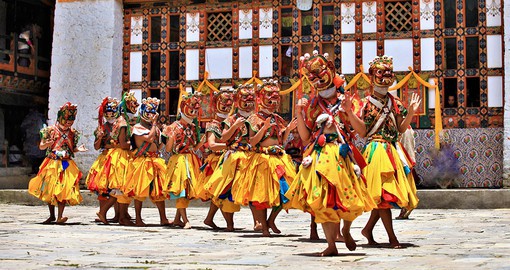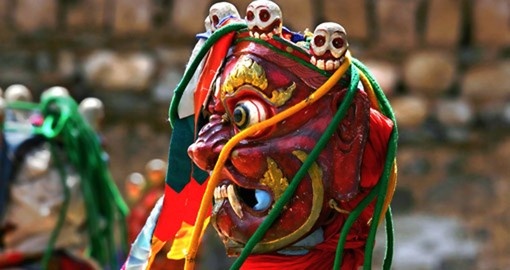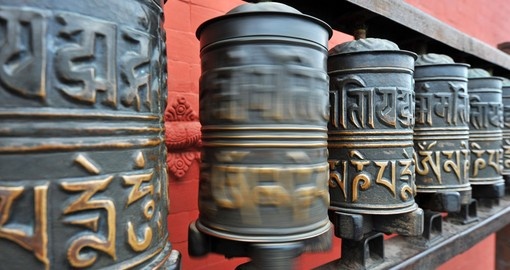Highlights of Bhutan: Thimphu, Punakha & Paro
- Duration
- 6 Days
- Prices From:
- AU$ 5,039
FIRST-CLASS | PRIVATE-GUIDED: Discover the wonders of Bhutan, a Buddhist kingdom in the Himalayas that is one of the world’s most eco-conscious and happy nations. You’ll tour the national highlights, including the capital, Thimphu, the mountain peaks of Dochula Pass, and the Paro Valley, home to the iconic Taktshang Monastery, known as the Tiger’s Nest.
This 6-day Bhutan vacation showcases the nation’s gorgeous landscape and main landmarks. It features first-class accommodation and private tours.
Begin your trip to Bhutan by connecting to Thimphu, the capital and largest city in the nation. While Bhutan is best defined by its traditional communities dotting the foothills and valleys of the Himalayas, this city of over 100,000 offers an easygoing slice of city life within the Buddhist kingdom. Head to the white spired National Memorial Chorten for an ideal introduction to Bhutanese culture, interacting with locals who circumambulate the shrine with prayer wheels and chants. Based in Thimphu, you’ll also tour some nearby villages and museums, including the Textile Museum and the Centenary Farmers Market.
Leave Thimphu behind and stop by the Dochula Pass, where you’ll enjoy views over several towering peaks, including Gangkar puensum, the highest peak in the nation. You’ll also spot the iconic prayer flags and stupas that layer the hillside. Continue to Punakha, the former capital, where you’ll visit Punakha Dzong, a massive palace with a six-story gold-domed tower and one of the nation’s most majestic religious and administrative centers. Onward to Paro, arguably the most scenic valley in the Himalayas and home to its most iconic sites. In Paro, you’ll visit several temples and monasteries, culminating in a trip to Taktshang Monastery or the Tiger’s Nest, the iconic monastery perching the side of a cliff 2,900 ft/900 m above the valley floor. You’ll also stop by a traditional Bhutanese farmhouse before capping off your valley tour.
At the end of your stay, head to the airport in Paro for onward travels.
- Duration
- 6 Days
- Prices From:
- AU$ 5,039
Itinerary View Trip Map
Arrive Paro and transfer to Thimphu
Welcome to the Kingdom of Bhutan. After immigration formalities and baggage collection, you will be welcomed by our representative with a 'tashi khaddar' (white scarf offering).
After the welcome ceremony, board the vehicle and drive to Thimphu, the capital town of Bhutan. The road leads through the Paro Valley to the confluence of Paro and Thimphu rivers at Chuzom (confluence). Shortly before reaching Chuzom, you will see on your left Tamchog Lhakhang, the temple built by Thangtong Gyalpo, a pioneering engineer who introduced the construction of suspension bridges in Bhutan and Tibet (several of which are still in use today). The present bridge to Tamchog Lhakhang was restored in 2005 in the design of a traditional style with iron chains and crossing this iron bridge is a wonderful experience. (approx. 50 min, roundtrip walk).
On arrival in Thimphu, check into the hotel. The capital town of Bhutan and the center of government, religion, and commerce, Thimphu is a unique city with an unusual mixture of modern development alongside ancient traditions. It is perhaps still the world's only capital city without a traffic light.
Later in the afternoon visit National Memorial Chorten, a large white structure crowned with a golden spire. It is located close to the center of Thimphu city and is one of its most iconic monuments. This is the most ideal spot to interact with locals who throng in large numbers to circumambulate the chorten, whirl the large red prayer wheels, and pray at a small shrine inside the gate. The paintings and statues inside the monument provide a deep insight into Buddhist philosophy.
Afterward an exploratory walk around Thimphu Main Street and the market area.
Accommodation: Norkhil Boutique Hotel & Spa
| Meal Plan | Dinner |
|---|---|
| Duration | 2 Nights |
Thimphu
This morning, take a short drive to the north of town to Buddha Dordenma, located atop a hill in Kuenselphodrang Nature Park. The statue fulfills an ancient prophecy dating back to the 8th century A.D. that was discovered by Terton Pema Lingpa (Religious Treasure Discoverer) and is said to emanate an aura of peace and happiness to the entire world. This massive statue of Shakyamuni made of bronze and gilded in gold, measures 51.5 meters in height, making it one of the largest statues, in Bhutan. 125,000 smaller Buddha statues have been placed within the Buddha Dordenma statue, each of these also has been cast in bronze and gilded. Here at Buddha Point, you have the option to perform meditation in a designated area.
Bhutan is known for its innovative postage stamps. The Postal Museum showcases the progress of postal services and to some extent the communication system in Bhutan along with the country's rare and unique stamps issued over the years. Continue on to visit the Postal office located next door to get your own personalized postal stamps made and check out various souvenirs.
Then drive to the Textile Museum. With the opening of the Textile Museum, under the patronage of Her Majesty the Queen Ashi Sangay Choden, Bhutanese textiles have reached new heights as one of the most visible distinct art forms. The textile museum has opened its exhibition on six major themes - warp pattern weaves, weft pattern weaves, the role of textiles in religion, achievements in textile arts, textiles from indigenous fibers, and the Royal collection.
This is followed by a visit to The Folk Heritage Museum, dedicated to connecting people to the Bhutanese rural past through exhibits, demonstrations, educational programs, and documentation of rural life. For an insight into the traditional crafts of Bhutan, visit National Institute for Zorig Chusum, established in 1971, it is the premier institute to preserve and promote thirteen traditional art and crafts of Bhutan. Commonly known as Arts & Crafts School or Painting School, the Institute offers 4-to-6-year courses in 13 traditional arts and crafts of Bhutan.
Then explore Centenary Farmers Market. Popularly known as the Weekend Market, this bustling, colorful market center is the biggest where farmers from different parts of the country gather to sell their farm products. With its wide assortment of products including handicrafts and its picturesque and colorful setting, the Farmer's Market is a favorite spot for many. Conclude the sightseeing of the day with a visit to Trashichhoedzong, the 'fortress of the glorious religion'. This is the center of government and religion, the site of the monarch's throne room, and the seat of Je Khenpo or Chief Abbot. Built-in 1641 by the political and religious unifier of Bhutan, Zhabdrung Ngawang Namgyal, it was reconstructed in the 1960s in a traditional Bhutanese manner, without nails or architectural plans.
| Meal Plan | Breakfast, Lunch and Dinner |
|---|
Thimphu to Punakha
After breakfast, drive up to Dochu-la pass stopping briefly here to take in the view and admire the chorten, mani wall, and prayer flags that decorate the highest point on the road. If the skies are clear, the following peaks can be seen from this pass (left to right): Masagang (7,158m), Tsendagang (6,960m), Terigang (7,060m), Jejegangphugang (7,158 m), Kangphugang (7,170 m ), Zongphugang (7, 060 m ), a table mountain that dominates the isolated region of Lunana - finally Gangkar puensum, the highest peak in Bhutan at 7,570m.
At Dochula Pass, 108 chortens or stupas known as Druk Wangyal Chortens have been built by Ashi Dorji Wangmo Wangchuk, the eldest Queen Mother. These chortens are built in three layers, the first lowest level layer has forty-five chortens, the second has thirty-six and the top layer has twenty-seven, built around the main chorten.
Then drive onward to Punakha. Punakha served as the capital of Bhutan and seat of government until 1955 and still, it is the winter seat of Je Khenpo (the chief abbot). Blessed with a temperate climate and owing to its natural drainage from Pho Chhu (male) and Mo Chhu (female) rivers, the fertile Punakha valley produces abundant crops and fruits. Located at an elevation of 1300m above sea level, Punakha enjoys mild winters and is a popular year-round destination.
After lunch, visit Punakha Dzong (Palace of Great Happiness), built at the junction of the Phochu and Mochu rivers in 1637 by Shabdrung Ngawang Namgyal. This majestic dzong served as both the religious and administrative center of Bhutan in the past. It measures some 600 by 240 feet and has a six-story, gold-domed tower. Inside are courtyards and religious statuary that hint at the depth of history and spiritual tradition embodied here. Your guide will illuminate your understanding of this intricate culture that is exotic to us, though long established here.
Then a short excursion to Chimi Lhakhang. The Chimi Lhakhang, situated on a hillock in the center of the valley, is also known as the temple of fertility. It is widely believed that couples who do not have children and want one, if they pray at this temple, are usually blessed with a child very soon. The trail leads across rice fields to the tiny settlement of Pana, meaning 'field'. A walk through the village near the temple will give you rare glimpses into the daily life and lifestyle of the villagers.
Evening, have a wander in and around the heart of Punakha town.
Accommodation: RKPO Green Resort
| Meal Plan | Breakfast, Lunch and Dinner |
|---|---|
| Duration | 1 Night |
Punakha to Paro
After breakfast, visit Wangduephodrang Dzong. Founded by Zhabdrung Ngawang Namgyal in 1638, on the top of the high ridge between Punak Tsang Chhu and Dang Chhu rivers, offering a fantastic of the valley below, Wangdue Dzong holds a special place in Bhutan's history. The strategic location of the dzong, provided Penlop (Governor) of Wangduephodrang, a chance to protect the routes to Trongsa, Punakha, Dagana, and Thimphu making him the third most powerful ruler after Governors of Paro and Trongsa. The Dzong had been damaged by fire in 2012 and was restored to its original grandeur and splendor recently (in 2022).
Then drive to Paro along the scenic highway. The beautiful valley of Paro encapsulates within itself a rich culture, scenic beauty, and hundreds of myths and legends. It is home to many of Bhutan's oldest temples and monasteries, the National Museum, and the country's only international airport. Mount. Chomolhari (7,314m) reigns in white glory at the northern end of the valley and its glacial water plunge through deep gorges to form Pa Chhu (Paro River). Paro is also one of the most fertile valleys in the Kingdom producing a bulk of the locally famous red rice from its terraced fields. Post lunch, proceed to visit Ta Dzong, originally built as Watchtower, which now houses National Museum. The extensive collection includes antique thangkha paintings, textiles, weapons & armor, household objects, and a rich assortment of natural and historic artifacts.
Ta Dzong visit is immediately followed by a short walk down the trail to visit Rinpung Dzong (Paro Dzong), meaning ("fortress of the heap of jewels"), which has a long and fascinating history. Along the wooden galleries lining the inner courtyard are fine wall paintings illustrating Buddhist lore such as four friends, the old man of long life, the wheel of life, and scenes from the life of Milarepa, Mount. Sumeru and cosmic Mandala.
Evening, explore Paro city center and the local market.
Accommodation: Tenzinling Luxury Tent Villa
| Meal Plan | Breakfast, Lunch and Dinner |
|---|---|
| Duration | 2 Nights |
Paro
After breakfast, embark on a fascinating excursion to Taktshang Monastery or Tiger's Nest (approx. 5 hours round trip walk): It is one of the most famous of Bhutan's monasteries, perched on the side of a cliff 900m above the Paro Valley floor. It is said that Guru Rinpoche arrived here on the back of a tigress and meditated at this monastery hence it is called 'Tiger's Nest'. This site has been recognized as a most sacred place and was visited by Zhabdrung Ngawang Namgyal in 1646 and is now visited by all Bhutanese at least once in their lifetime.
Late afternoon, drive the end of the Valley to the newly restored Drukgyel Dzong. Built by Zhabdrung Ngawang Namgyal in 1646 to commemorate an early military victory over Tibetan invaders, the dzong name means, indeed, 'victorious Druk'. Historically and strategically, this Dzong withstood all its glory and was featured in 1914 vide National Geographic magazine. The glory of Drukgyel Dzong remained even when it was destroyed by fire in 1951. On a clear day, one can see the commanding view of Mount. Chomolhari (7,314m) from the village, below the Dzong.
Neary by we will also visit a typical farmhouse. Bhutanese farmhouses are very colorful, decorative, and traditionally built without the use of a single nail. The majority of the population of Bhutan continues to live as it has for centuries -- in small, isolated farms and hamlets, surrounded by terraced fields of rice, maize, and buckwheat. While driving to Paro town, stop en route at the 7th century Kyichu Lhakhang, one of the 108 temples built in the Himalayas by Tibetan King, Songtsen Gampo. The building of this temple marks the introduction of Buddhism in Bhutan.
| Meal Plan | Breakfast, Lunch and Dinner |
|---|
Depart Paro
In the morning, drive to the airport for your flight. Our representative will help you with exit formalities and then bid you farewell.
| Meal Plan | Breakfast |
|---|
Other Information
DEPARTURES:
Daily
PRICE INCLUDES:
- Private arrival and departure airport transfers
- 2 nights first-class accommodations in Thimphu
- 1 night first-class accommodations in Punakha
- 2 nights first-class accommodations in Paro
- Private-guided tours including entrance fees as per itinerary
- Private-guided transportation as per itinerary
- English-speaking guide service
- Sustainable Development Fee and taxes
- Bhutan Visa Fee
- Breakfast daily (excluding day 1), 4 Lunches, 5 Dinners
PRICE EXLUDES:
- Travel insurance
- International and domestic airfare & airfare taxes
- Visa fees if applicable
- Meals and beverages not mentioned
- Gratuities
- Items of a personal nature
TERMS AND CONDITIONS:
Prices are "from" per person based on twin/double share accommodation and for travel in low season. Seasonal surcharges and blackout dates may apply. Limited seat/spaces and all pricing is subject to change and availability. Rates for single or triple travellers are available on request - please inquire.
10 Jul 2024







